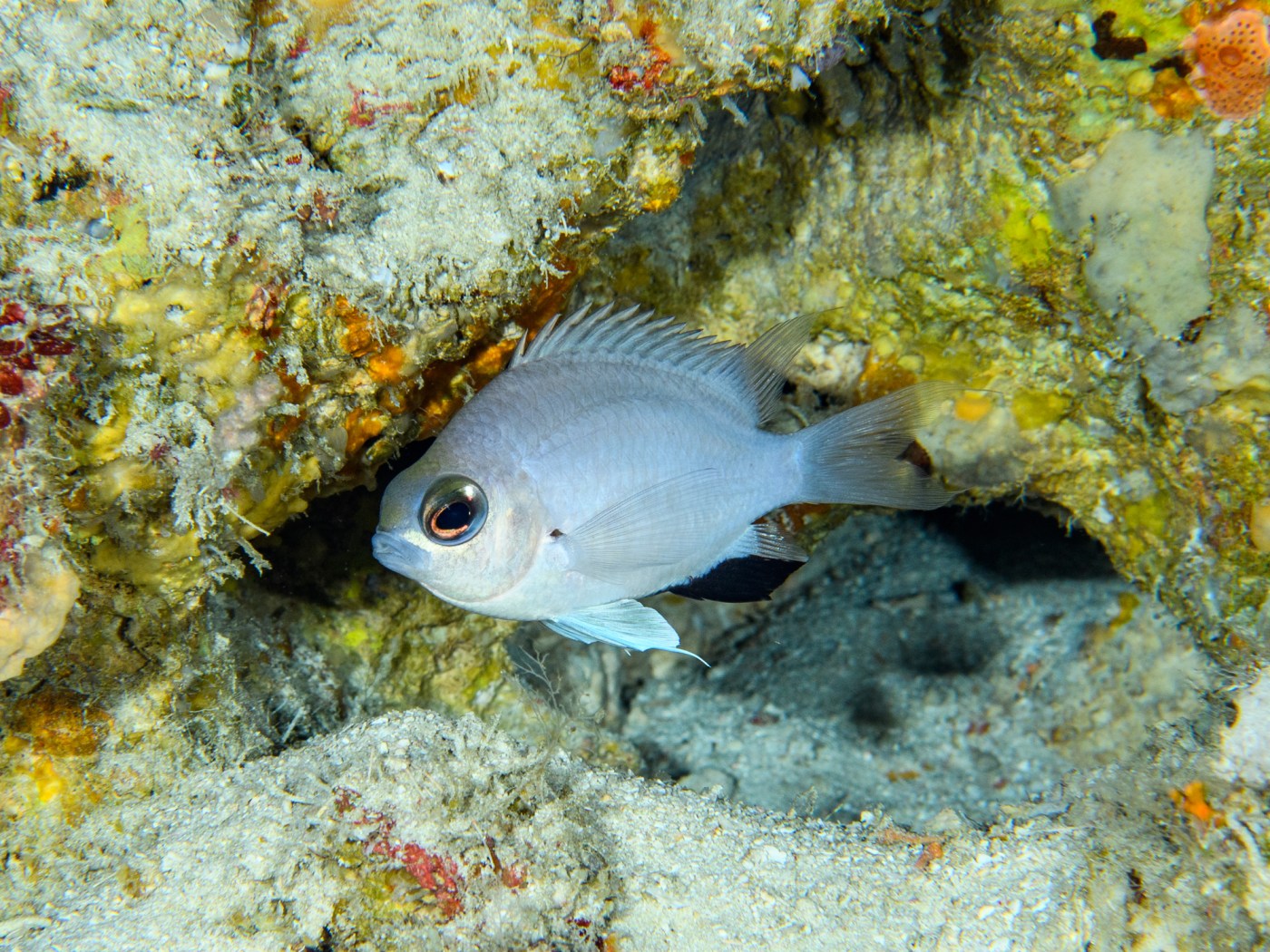Luiz Rocha was scuba diving 460 feet beneath the surface of the Indian Ocean when a flash caught his eye: a small damselfish with big eyes, perched on a colorful reef.
Rocha, a scientist and curator at the California Academy of Sciences in San Francisco, thought the fish was so unusual that it might actually be an undiscovered species. Two years later, he was able to confirm his suspicions with a team of researchers, and described his find in a paper published last month.
The damselfish, officially Chromis abadhah, is one of 138 animals, fungi and plants from around the world that Academy of Sciences researchers confirmed as new discoveries in 2024. They include 31 other fishes, dozens of bugs, an endangered dahlia, two deep-water ghost sharks, and a striped spider from Madagascar. The Academy is just one of many institutions globally that document new species.
Stenopelmatus nuevoguatemalae, commonly called the Jerusalem cricket, was found in Guatemala. (Photo by David Weissman)
These new-to-science specimens were spotted by scientists like Rocha in their habitats on several continents and in the waters around them and confirmed in a long, scientific process called “description.”
Scientists who discover new species have the honor of naming them. This year’s list includes a “plant bug” named after outgoing Vice President Kamala Harris: Pseudoloxops kamalaharrisae, a yellow creature with long antennae found in French Polynesia. Another bug was named for actor Harrison Ford. Academy researcher Brad Balukjian, who co-discovered both, said in a news release that he wanted to honor the politician’s and celebrity’s commitments to conservation and climate science.
Shannon Bennett, a virologist and chief of science at the Academy, said the discoveries speak to humanity’s responsibility to catalog and conserve Earth’s rich biodiversity. Species are being snuffed out because of human activity at a terrifying rate — so fast that scientists call this era a “mass extinction,” like the asteroid that took out dinosaurs 66 million years ago.
“You cannot care about what you don’t know about,” Bennett said.
Scientists estimate that they’ve discovered just one-tenth of the planet’s species, Bennett said. Typically, researchers come across new creatures while examining something else. That’s how Rocha came across the sleek damselfish two years ago.
An expert in deep-water scuba diving, Rocha trekked to the Maldives, a tiny island country in the Indian Ocean, to survey its deep reefs.
These colorful bands of coral lie at depths between 100 feet and 500 feet and, like many of the world’s deep reefs, had never been seen by humans, Rocha said.
Water filters enough light at that depth that divers call it the “twilight zone.” But the distinctive damselfish, white-and-blue hued with elegant fins, caught Rocha’s eye.
Rocha snapped a photo and returned the next day. Because the fish were abundant, he collected four specimens for later study. It was a long journey, and the fish did not survive. Rocha could only spend eight minutes at that depth to save enough time for a four-hour ascent to the surface, rising slowly to avoid a dangerous buildup of gases known as “the bends.”
Rocha had a hunch that the species was new to science but needed confirmation. What followed was a lengthy process, in which he and a team of Academy researchers studied the fish’s traits and compared them to others. The results were published in the peer-reviewed journal ZooKeys.
To name the fish, Rocha collaborated with Maldivian locals and settled on a name in a local tongue: “abadhah,” which translates as “perpetual.” Rocha wants the species and its colorful habitat to be everlasting, he said, and he hopes the name will inspire conservation efforts. Even though humans had never before laid eyes on the deep reef where he found the damselfish, the signs of over-fishing, plastics and pollution were obvious, Rocha said.
Related Articles
Flam: Black spatula saga shows the danger of hyping science
5 things we know and still don’t know about COVID, 5 years after it appeared
Opinion: Separating science and the humanities is hurting us
How a flying ferry could help solve Tahoe’s traffic problem
Opinion: Why does the U.S. still have lead pipes? Blame this trade group
Other water-dwelling animals confirmed as new discoveries this year include a goby found in Bali, Indonesia, that resides in giant sponges; a slew of marine worms; eerie ghost sharks that live at deep depths; and a tiny pipehorse the size of a golf tee found in South Africa.
On land, the discoveries include a brilliantly colored dahlia in the Mexican state of Oaxaca that’s critically endangered — a rare distinction — and a 100-million-year-old fossil of a skink — a kind of lizard — that was preserved in amber in Myanmar.
Bennett said that the rate of confirmations this year is about average. She expects “many, many more” in 2025.
Enneapterygius viridicauda, another stunning variety of triplefin recently discoverred in Indonesia by Academy of Sciences researcher Mark Erdmann. (Photo by Mark Erdmann)
A flowering plant, Cryptantha whippleae, found in the Shasta-Trinity National Forest in California’s Siskiyou County. (Photo by Dana York)
Enneapterygius rubrimarginatus, a new-to-science variety of triplefin found in Indonesia by Academy of Sciences researcher Mark Erdmann. (Photo by Mark Erdmann)
Tabiboka milleri, one of three crack-leg spiders found in Madagascar. This species sports tiger-like stripes on its cephalothorax and abdomen. (Photo by Nikolaj Scharff)
Graham Short, an Academy of Sciences research associate, discovered this tiny pipehorse off the coast of South Africa. Its name, Cylix nkosi, is taken from the Zulu word for “chief.” (Photo by Richard Smith)
Bathygobius mero, a goby with eyes like nebulas that dwells in sponges. This species was discovered near Bali, Indonesia by Academy of Sciences researcher Mark Erdmann. (Photo by Mark Erdmann)
Panaspis ericae, one of two snake-eyed skinks discovered in the central African nation of Angola by Academy of Sciences herpetologist Aaron Bauer. (Photo by Aaron Bauer)












